There are many different couplers for use with H0 gauge models – provided they have NEM 362 coupler pockets. I introduce five couplers that are frequently used in the three-rail world.
What are Close Couplers? What is a Guiding Mechanism?
Close couplers couple close. But that would be too simple, so that’s not all. When coupled, they make a rigid connection as it is needed to make the close coupler guiding mechanism work. The guiding mechanism reduces the spacing between cars on straight track and increases it in curves – in the best case, cars will run buffer to buffer on straight track. The guiding mechanism requires close couplers that make a rigid connection to work properly.
This picture shows four different close couplers that are frequently used with H0 models:

Märklin Close Coupler
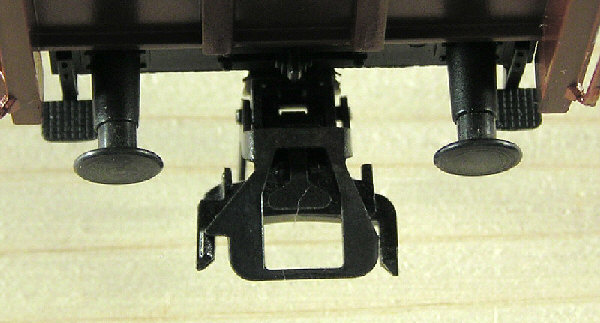
The most common coupler in the H0 three-rail world is the Märklin Close Coupler, coming with most models by Märklin and Trix (except some entry-level models that come with the Relex coupler which will be introduced later). Disadvantages: will not couple if couplers are slightly misaligned, cannot be used with third-party rolling stock that has buffers at scale height.
Roco Universal Coupler
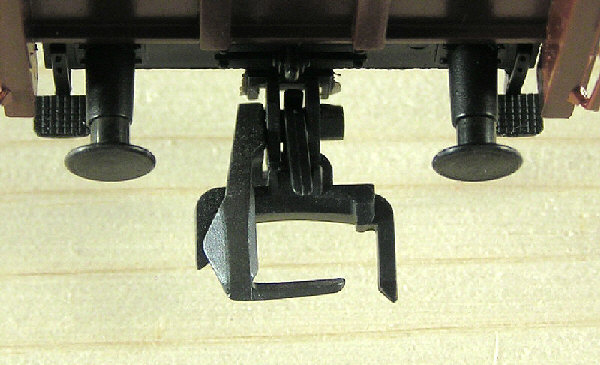
The Roco Universal Coupler used to be the standard coupler of Roco “AC” models before the Roco insolvency. Due to patent problems it is no longer included with Roco “AC” locos, but can be bought in packs of 12 or 50 pieces. It couples with the Märklin Close Coupler, it couples more easy than the Märklin Close Coupler, it can be used with third-party rolling stock with scale buffer heights. Truly universal. I use this type of coupler for almost all my non-MäTrix freight cars.
Roco Close Coupler
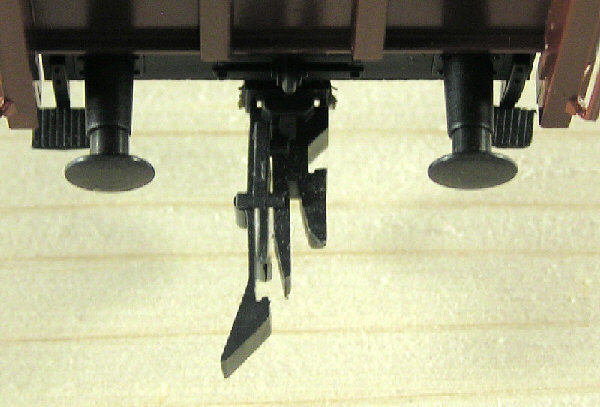
The Roco Close Coupler is the default coupler for Roco coaches. Roco locos normally include a pair of those, too. I use this type of coupler for almost all non-MäTrix coaches. Roco coaches come with them, for other brands I primarily use the Roco Close Couplers that came with my Roco “AC” locos (I use Roco Universal Couplers for those locos).
Advantages: can be decoupled by lifting one of the cars. Disadvantages: can decouple accidentally if there are sudden changes of incline on the layout.
The Fleischmann Profi Coupler
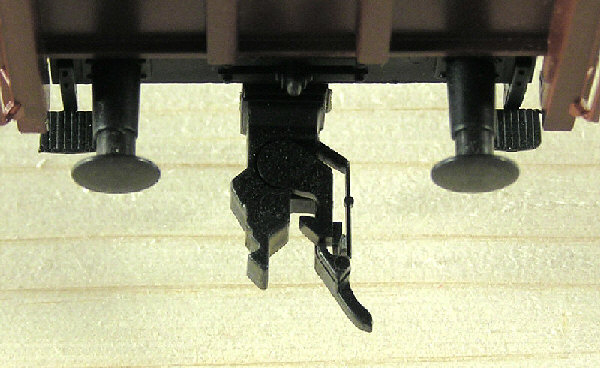
This coupler is similar to the Roco Close Coupler. It has the same advantages and disadvantages.
The Buffer Height Problem
I already mentioned that the Märklin Close Coupler can lead to problems with non-MäTrix rolling stock where buffers are at the correct scale height.
Here’s a picture with two Märklin freight cars to illustrate this (there is no problem with these cars as the buffers are high enough, but you’ll also see other couplers later).
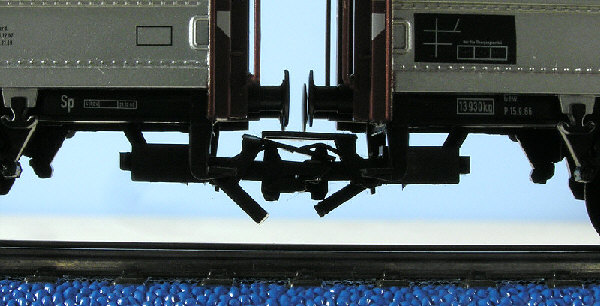
And for contrast, two cars of the same type, but this time with Roco Universal Couplers:
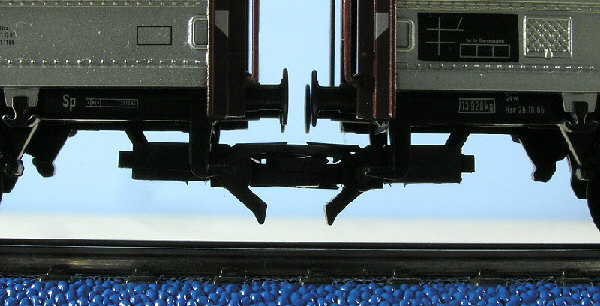
It’s easy to see the gap between couplers and buffers – there was no gap on the preceding image with the Märklin Close Couplers.
Here is an image where one freight car has a Märklin Close Coupler, the other has a Roco Universal Coupler:
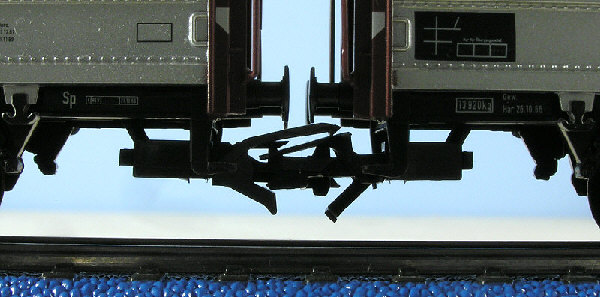
The couplers work fine together and couple more easily than a pair of Märklin Close Couplers, but there is no gap between buffers and couplers. Therefore do not mix those two coupler types when connected rolling stock with prototypically correct buffer height.
And now close coupler number 3, the Roco Close Coupler:

The gap between couplers and buffers is bigger than with Roco Universal Couplers. And the gap between the buffers (the distance between the cars) is smaller than before – more important for coaches than for freight cars in my humble opinion.
And finally a picture showing a pair of Fleischmann Profi Couplers:
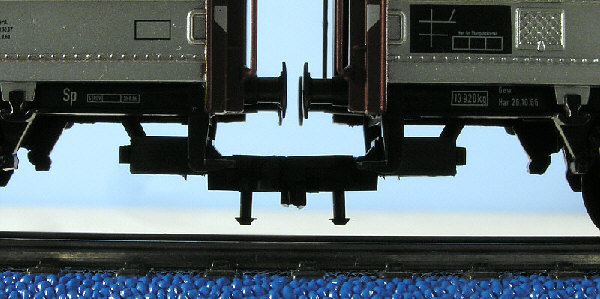
The gap between couplers and buffers is similar to the Roco Close Couplers.
Relex Couplers
Relex Couplers are the other coupler type frequently used by Märklin, especially for entry-level rolling stock.
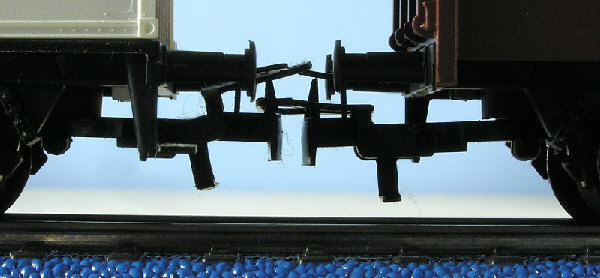
No rigid connection, so there can be problems with push/pull trains or if train stops suddenly (especially downhill). Coupler height is not a problem since there is no rigid connection. Gap between cars is normally rather huge.
Close Couplers without Guiding Mechanism
Hobby freight cars can use the Close Couplers from the Märklin 7203 set, but then they still won’t have a guiding mechanism and the gap between the cars will be just a bit smaller.
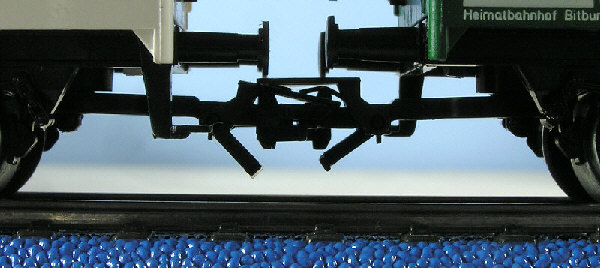
The rigid connection of the 7203 Close Couplers will prevent problems with push/pull trains or sudden stops.
Mixing Märklin Close Couplers and Märklin Relex Couplers
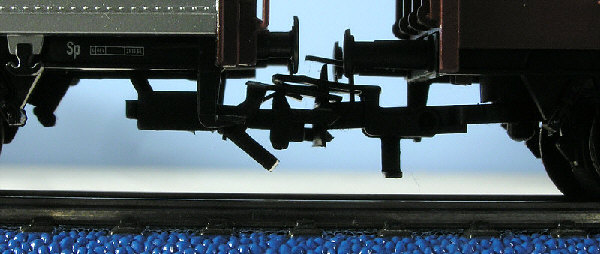
These types of couplers can be mixed, but won’t give a rigid connection, so the disadvantages of Relex couplers also apply to this mix.
Working Around the Buffer Height Problem
Here’s a Märklin loco with Märklin Close Coupler and a Roco coach with Roco Universal Coupler:
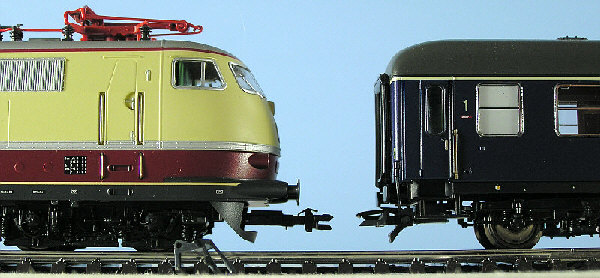
There will be no problem coupling loco and coach – because I removed the metal loop from the Märklin Close Coupler of the loco (you can see it lying beside the track).
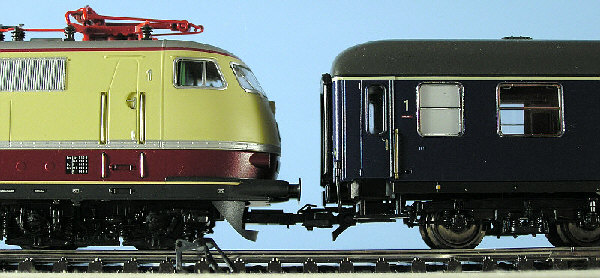
A few of my Märklin locos have those “work-around couplers” (some have Roco Universal Couplers).
Different Couplers Lead to Different Distances
Finally I have some pictures that illustrate the different distances that result from different coupler types.
The first picture shows decoupled Roco Close Couplers:
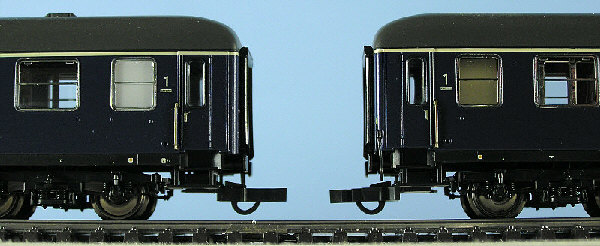
The next picture shows the coaches after coupling:
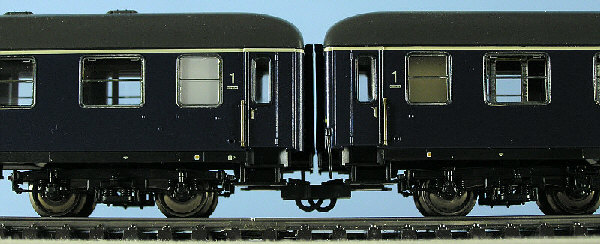
And for contrast coaches of the same type coupled with Roco Universal Couplers:
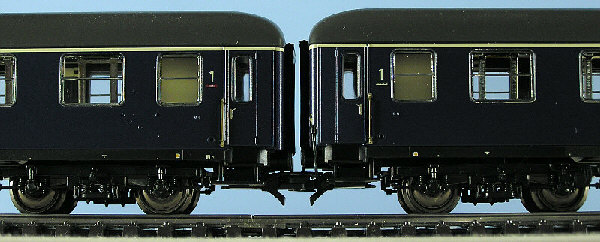
The gap between the coaches is a little bit bigger.
Thanks very interesting to see all the couplers I’ve read about and not had as well describes as you’ve done here.
First class information. I use mostly Märklin close couplers and cannot change easily because of many Telex couplers I have. The main issue with Märklin close couplers is their reluctance to couple when height or central positioning is not correct. The Roco Harpoon works probably very fine but is not very discreet and does not work with Telex couplers. I tried Roco universal couplers. They seem fine but fragile (especially in the pseudo loop region).
The Roco Universal coupler has a metal “pseudo loop”. I installed hundreds of those and didn’t have problems with that part yet.